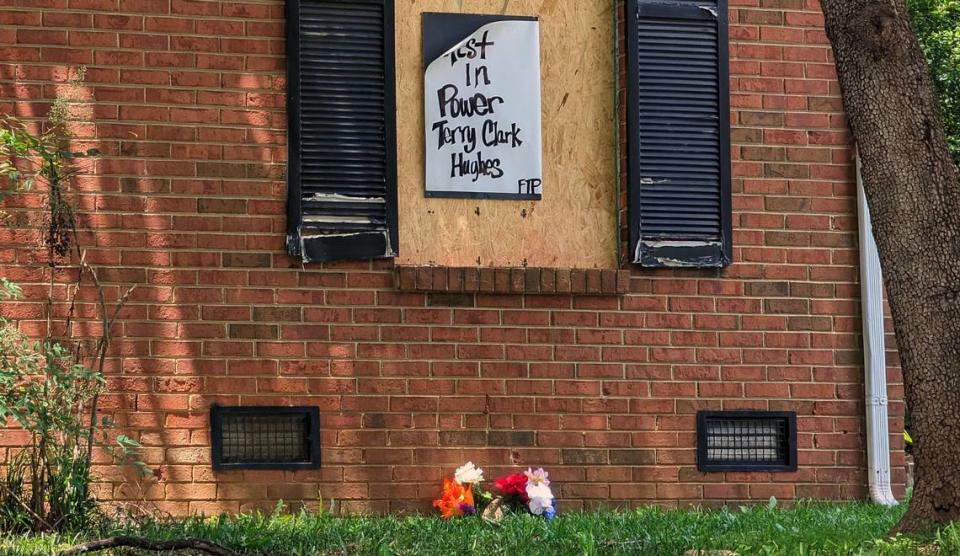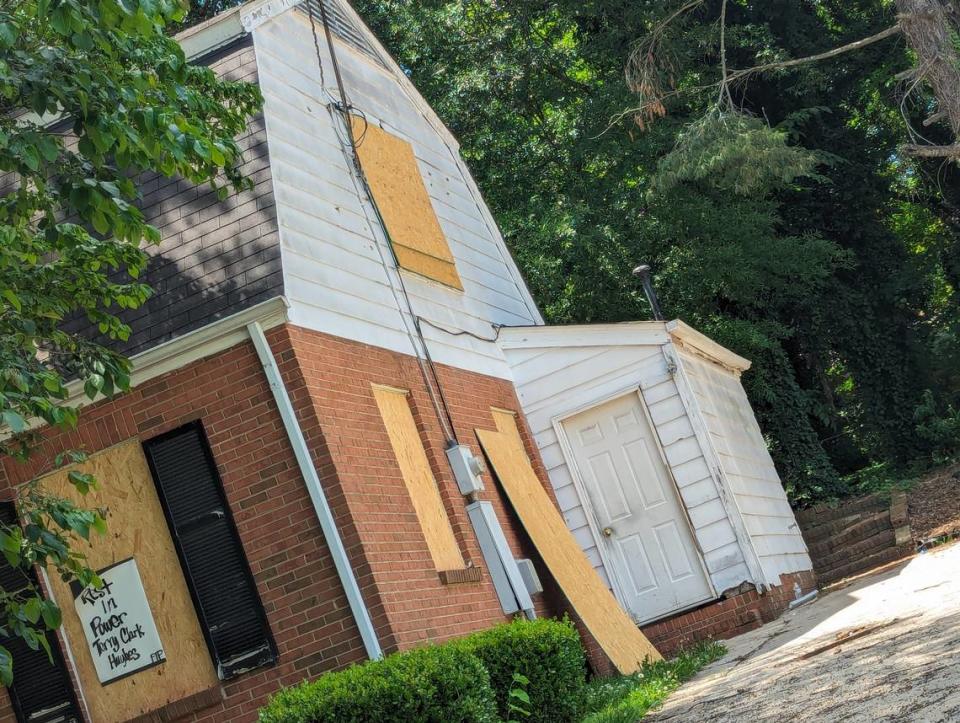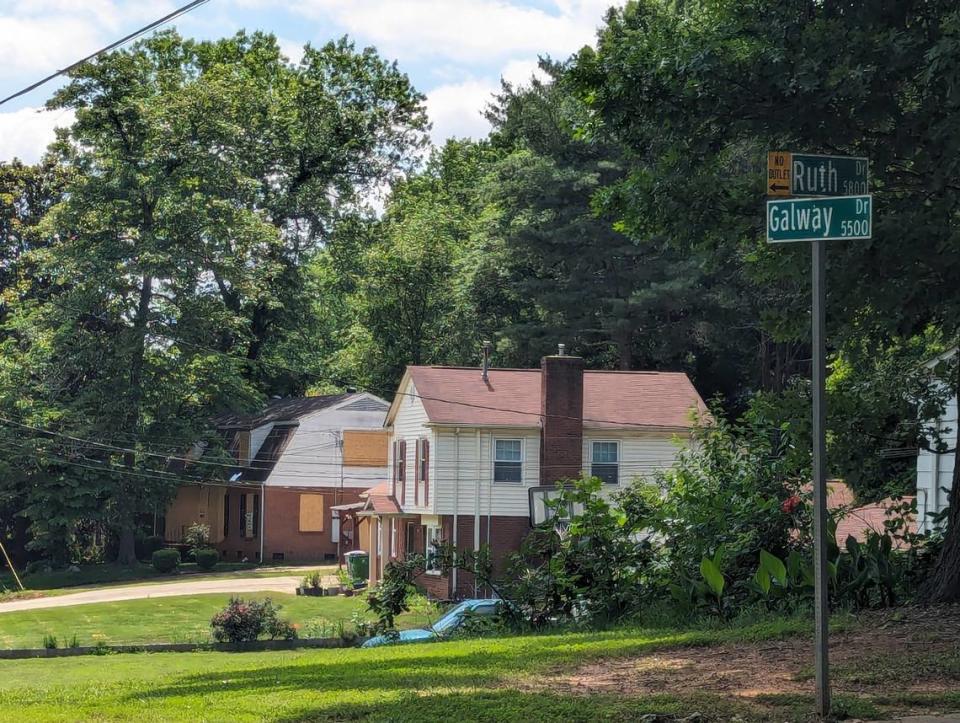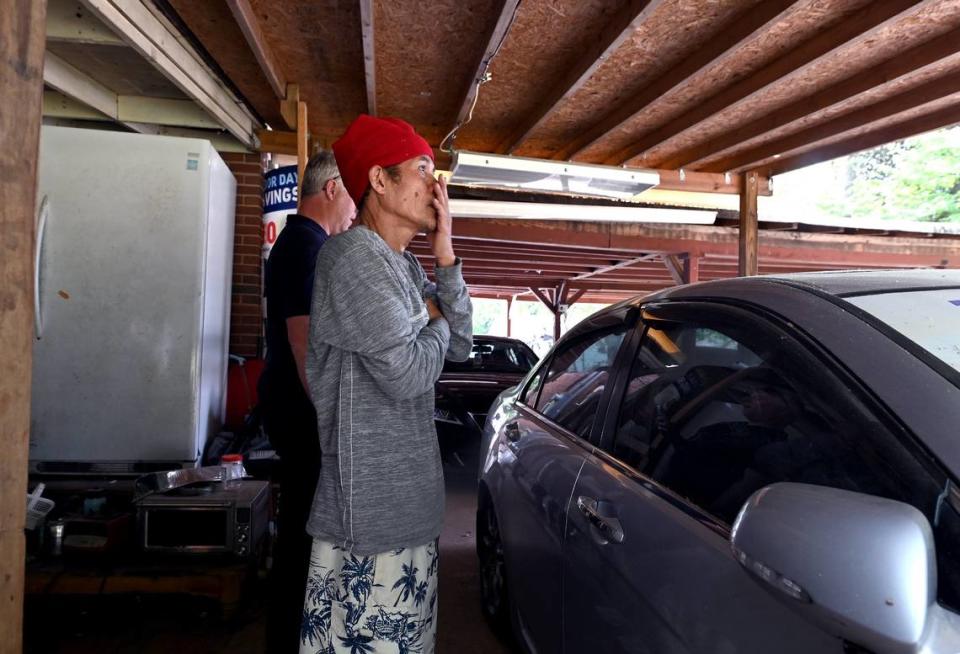Fate of damaged Charlotte house where shootout killed four officers remains murky
A month after a deadly shootout with police erupted at a Galway Drive house in east Charlotte, the front of the badly damaged home and its windows are boarded up. Its white plank siding is pockmarked with what appear to be bullet holes.
That’s evidence of one of the deadliest days in North Carolina law enforcement history, a day that claimed the lives of four officers. A U.S. Marshals Task Force was there to serve a warrant on Terry Clark Hughes Jr., who died in the shoot-out during a three-hour standoff at the rented home.
Among the many questions remaining: What happens next to the rented house and neighboring homes on Galway Drive in need of repair?
The answer is not clear. City officials have refused to answer questions from The Charlotte Observer about whether the house will be demolished or who would be liable to pay to fix all the damage.
The city did order the homeowner of the rental house to “secure” the property and clean up the debris, according to a statement emailed May 2 from city spokesperson Lawrence Corley III. The homeowner declined to comment.

Generally speaking, if a government agency — from police to road maintenance — carries out its duties under the law and without negligence, it would receive sovereign immunity, said Scott Mooneyham, director of political communications and coordination for N.C. League of Municipalities.
“Courts have routinely held that the police may damage or destroy property when it is objectively necessary to prevent imminent harm to persons,” said Abraham Rubert-Schewel, a civil rights attorney at Tin, Fulton, Walker and Owen in Durham. “The legal question here will likely be whether the damage done to the property was necessary to prevent imminent harm to persons.”
Across the country, property owners have sued local governments seeking compensation after police actions destroy their homes. This comes at a time when departments are using more military gear such as armored trucks, experts say.
“This type of damage to personal property during police raids has increased as law enforcement has become increasingly militarized,” Rubert-Schewel said.
Signs on a badly damaged home
On April 29, Hughes fired at least 100 rounds from a high-powered rifle outside the Galway Drive home as a U.S. Marshal Task Force, including Charlotte Mecklenburg Police Department officers, tried to serve him a warrant, Charlotte-Mecklenburg Police Chief Johnny Jennings said during a news conference April 30.
In addition to the four officers killed, four more were shot but survived. Two other people in the home during the shooting were questioned by police.
As part of their effort to stop the standoff, Charlotte-Mecklenburg police deployed a dark gray armored vehicle to smash into the front of the house.
The front of the red brick house where the shooter was holed up suffered extensive damage. The exterior wall was crumbled, providing a shattered vista into the entrance, a bedroom and part of the living room.
On May 21, the front of the house at 5525 Galway Drive and all of its windows were boarded up. At the top of the front steps, near a mangled black railing, the city Code Enforcement Office has posted a sign on plywood where the front door would have been that states: “Unsafe Keep Out.”

Despite much public grieving and too many funerals, someone posted another, jarring sign on the boarded-up front right window. It read: “Rest In Power Terry Clark Hughes,” along with “FTP,” an apparent slang phrase cursing police.
The Shannon Park community was quiet on May 21 as neighbor Bernie Kuebler drove by showing a coworker the battered house.
“People come by every day. It’s an eyesore,” said Kuebler, who lives just around the corner.
Shutting his eyes and putting his head down, Kuebler talked about the four officers killed as part of the task force that tried to serve Hughes with a warrant. And about the families of the men: Sam Poloche and Alden Elliott with N.C. Department of Adult Correction, Deputy U.S. Marshal Tommy Weeks Jr. and Joshua Eyer with CMPD.
Four U.S. Marshal peer support team members from out of town also stopped by to access the scene but they declined to comment.
What the city told the homeowner
The four-bedroom house at 5525 Galway Drive was built in 1965, Mecklenburg County property records show.
The 2,272-square-foot, 1.5-story home on just over a quarter-acre was purchased in 2003 for $93,000. The latest tax value is $326,300, records show. The Observer is not naming the homeowners because they are not facing any violations or charges related to gunfight.
On May 2, the city emailed a statement to the Observer that said the homeowner would be responsible for removing yard debris and “securing” the property.
The statement said: “To ensure the safety and security of the neighborhood, Code Enforcement is taking the following proactive approach:”
▪ The property owner has seven to 10 days to bring the yard into compliance.
▪ The owner must secure the home within seven to 10 days to help prevent unauthorized access and further damage.
▪ There will be an inspection to ensure all minimum housing code violations are addressed.
On May 8, City Attorney Patrick Baker told the Observer he was aware there would be inquiries and claims from property owners related to the law enforcement activities. That includes the 5525 Galway Drive home and neighboring homes damaged during the shootout.
“We are working with our risk management division to manage those claims,” Baker said. “The policy on how to handle those claims would come from risk management with legal support from us.”
The city’s risk management office referred questions from the Observer about the policy back to Baker.
In a May 14 email to news outlets regarding questions about the status of the Galway house, Corley said the code enforcement and risk management process is underway. “CMPD will also share details at the appropriate time once the investigation is complete.”
The Observer has filed Freedom of Information Act requests for information about policy and protocols when private property is damaged by police, as well as the number of times CMPD has deployed a SWAT vehicle. The Observer also reached out to Mayor Pro Tem and District 1 city councilman Dante Anderson, whose district includes the Galway Drive house. She did not respond to requests for comment.

How other states handle the issue
In Texas, the appellate court has ruled the government was not required to compensate a homeowner if it was necessary for officers to damage or destroy property to ensure public safety, according to the Police 1 website, which focuses on law enforcement issues.
The homeowner’s insurance also refused to pay for intentional damage caused by the police and the city of McKinney refused to pay for any damage.
“But as long as suspects hide or circumstances warrant no-knock actions, there will be property damage,” Ken Wallentine, chief of the West Jordan, Utah, Police Department and former chief of law enforcement for the Utah Attorney General, wrote in the Police 1 article.
In a 2015 Colorado case following a 19-hour SWAT operation, the wooden frame of a house was exposed and much of the interior was reduced to rubble after police used explosives to blast holes in the walls and breached doors with an armored vehicle, The Denver Post reported. An armed shoplifting suspect had barricaded himself at random in the house.
The homeowner’s insurance covered some of the damage, but it wasn’t enough to cover the total costs for demolition and incidentals, including nearly all of the belongings inside that were damaged, the newspaper reported.
The U.S. District Court of Appeals for the 10th Circuit ruled police were “acting in their lawful role” and not liable for property damages, even if the damage occurred to property owned by someone not involved in a crime.

Damage to nearby homes
A neighbor’s house also sustained damage during the Charlotte shoot-out.
Saing Chhoeun and his son Jay were shocked when looking at the damage to their property next door. Police used parts of their house for cover during the firefight, and drove an armored vehicle through the backyard, damaging parts of the property on the way to the shoot-out, Chhoeun said.

Deep tire tracks carved a path from the front yard to the back, crushing a stone patio and destroying a wood awning on the side of their house. Fencing in the front and backyard was also run over, as well as several of Chhoeun’s plants and other items in the backyard.
The son and father told the Observer the day after the shooting, they understood the damage was necessary but unfortunate. They said then that they were researching how they could get help.
“We came out and looked at the aftermath and it was just crazy,” Jay said. “We didn’t ask for none of this.”
Neighbors like Kuebler are anxious to see what happens next.
“They probably need to knock that (house) down and rebuild because that’s a bad memory,” he said. The tarnishes what Kuebler said has been a great a place to live since he moved to the Shannon Park neighborhood in the late 1990s from New Jersey.
“There are people around here that want answers about what’s going on,” Kuebler said.
Advice for homeowners
Most police agencies have policies and procedures for when officers damage private property, said Christopher Mercado, adjunct assistant professor at John Jay College of Criminal Justice and a retired New York Police Department lieutenant.
“With most departments today, you will be able to get some payment or repayment, but you may have to lay out the money first,” Mercado said. “I would make the claim right away.”
Looking at photos of the Galway house damage, Mercado said “to say Swiss cheese is probably an understatement.”
But is the damage excessive? It depends on several factors, Mercado said, including the actions of all parties involved and the reasonableness of the officers’ actions at the time.

Assessing the damage and how everything unfolded, Mercado said the situation likely necessitated such force.
Typically, homeowners have two options to cover homes damaged by authorities. File a claim with their insurance companies or file a civil claim to sue for damages.
Here are five steps for homeowners that Mercado suggested:
▪ Take photos and video of the damage as soon as possible.
▪ Get official estimates for repairs.
▪ Get witness statements (notarized if possible), and write what you witnessed along with a timeline of events.
▪ Request body-worn camera footage for all officers involved.
▪ File a public records request for all paperwork associated with your case.
“Don’t wait and don’t be foolish about taking a proactive position to reclaim funding to pay for damages,” Mercado said.
Also, be careful speaking with lawyers who may promise a payday to recoup funds, Mercado said. “No ethical attorney would make grandiose promises about getting a room or a house rebuilt. Paydays take a long time.”
Observer reporter Jeff A. Chamer contributed to this report.
NC Reality Check reflects the Charlotte Observer’s commitment to holding those in power to account, shining a light on public issues that affect our local readers and illuminating the stories that set the Charlotte area and North Carolina apart. Have a suggestion for a future story? Email realitycheck@charlotteobserver.com


